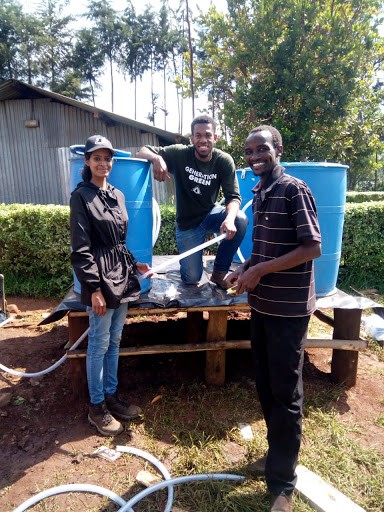A Network of Drinking Water Treatment & Monitoring in Rural Schools in Kenya
The Challenge
Cell phone-based drinking water quality monitoring in Rural Areas.
Delivering safe drinking water to small rural communities in developing countries is a last-mile problem. This problem contributes to why over 600 million people currently do not have a safe drinking water supply (this is 9% of the world’s population). Infrastructure costs dictate that the water must be produced near the point-of-use, which also dictates that the local consumers are responsible for ensuring water safety and water quality. But how?
A Market Study was performed in 2015 by Maji Safi International about water availability and treatment at schools in Nandi County in Western Kenya. Of the 42 rural schools surveyed (of 1006 total schools in the county), 24% directly used an unimproved surface water source for their drinking water needs. If this random sampling of schools reflects all the schools in the county, then over 200 schools in this one county are predicted to use an unimproved surface water as their drinking water. In Kenya, only 12% of the rural population has access to piped drinking water. This trend is repeated across the developing world. The need is clear: The National Academy of Engineering has listed “Provide access to clean water” as one of the 14 Grand Challenges for Engineering in the 21st century.
The Purdue Innovation: The CT Meter (Chorine-Turbidity Meter)

Our overarching objective is to design technologies for producing drinking water from surface water sources in rural areas of developing countries, to be implemented by local companies, NGO’s, or governments, with measurable results (i.e., meeting local drinking water quality criteria). We have previously designed and implemented slow sand filters (or bio-sand filters) in many schools in Colombia, Kenya, and elsewhere with great success. The filters significantly improve water quality by removing particles and dissolved organic chemicals from the water, reducing turbidity to drinking water standards, and allowing the water to be disinfected through the addition of chlorine. Most other slow sand filter uses gravel layers at the bottom of the filter as the “water collection zone”. Our filters do not use gravel. Instead, we use a porous plastic plate enclosed within a mesh bag. As a result: (1) there is only one media (sand) to prepare (sieve and rinse); and (2) if a filter becomes clogged, all the sand can be removed and rinsed, making for easy maintenance. Construction is simple. For this demonstration project, we will be installing slow sand filters in five large schools in rural Kenya, near Eldoret.
When chlorine is added to a water with a high concentration of organic matter, a significant amount of the chlorine is lost due to oxidation of the organic matter. This is why the dissolved and particulate organic matter must be removed prior to chlorination. Even when most of the organic substances are removed, there is a small “chlorine demand”, such that knowing the proper dose of chlorine to add requires measuring the “chlorine residual” (i.e., the chlorine concentration in the water after chlorine addition). As a result, we are developing a cell-phone based meter that can monitor both turbidity (before and after slow sand filter treatment), and chlorine concentration (after chlorine addition), for teachers to use in the schools, monitoring water quality daily.

Deliverables
- In August-October, 2019 we will install slow sand filters in 5 rural schools in Western Kenya.
- In August-December, 2019 we will complete the design and testing of the CT-meter, and construct 5 units (document work in a journal article)
- In January-July, 2020 we will deploy CT-meters in schools in Western Kenya (open from Jan-March, and open again May-July) to collect daily water quality data.
- In January-August we will assess the data and document in a second peer-reviewed journal article.
Typically, when point-of-use drinking water methods are employed by NGOs or other agencies, there is little to no monitoring of water quality and there is no long-term connectivity to ensure proper function. One of our key innovations to address these shortcomings is the use of cellphone connectivity to provide continued monitoring and network-based communal problem solving in the future. Through the phone APP, schools will be able publish their system’s performance, water quality results, system or management challenges, and get advice as needed. The phone-APP also will enable timely data sharing with regulators and other relevant stakeholders.
The Partners
Chad T. Jafvert, Ph.D., Purdue University, School of Civil Engineering, and Division of Environmental and Ecological Engineering
John Howarter, Ph.D., Purdue University, School of Materials Engineering, and Division of Environmental and Ecological Engineering
John Maiyo, Environmental and Ecological Engineering (EEE) Graduate Student at Purdue University, and Manager of Maji Safi International, Eldoret, Kenya

